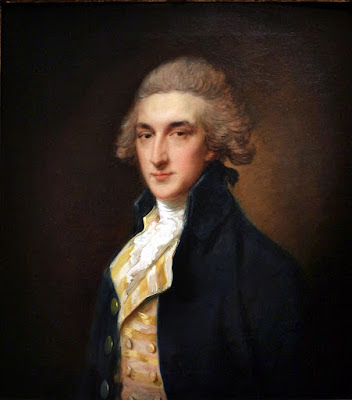 |
| Jean-Louis Laneuville Portrait of Jean Debry ca. 1793 oil on canvas Eskenazi Museum of Art, Indiana University, Bloomington |
 |
| Jean-Baptiste Greuze Portrait of writer Louis-Sébastien Mercier 1792 drawing Château de Versailles |
 |
| Henri-Pierre Danloux Portrait of a Young Man 1791 drawing Musée du Louvre |
 |
| Samuel De Wilde Richard Wilson as Sir Francis Wronghead in The Provok'd Husband by Colley Cibber ca. 1790 oil on canvas Holburne Museum, Bath |
 |
| François-André Vincent Study of a Young Women ca. 1790 drawing Musée du Louvre |
 |
| Thomas Gainsborough Portrait of Mary, Lady Bate-Dudley ca. 1787 oil on canvas Tate Britain |
 |
| Thomas Gainsborough Portrait of Sir Edward Swinburne 1785 oil on canvas Detroit Institute of Arts |
 |
| Henri-Pierre Danloux Portrait of a Young Woman ca. 1785 drawing Musée du Louvre |
 |
| Élisabeth Vigée-Lebrun Study of a Girl wearing a Veil 1785 drawing Musée du Louvre |
 |
| Samuel De Wilde Joseph George Holman as Chamont in The Orphan by Thomas Otway 1785 oil on canvas Museum of London |
 |
| Gilbert Stuart Family Portrait ca. 1783-93 oil on canvas Indianapolis Museum of Art |
 |
| Joshua Reynolds Portrait of Miss Elizabeth Keppel, later Mrs Thomas Meyrick 1782 oil on canvas Ashmolean Museum, Oxford |
 |
| Thomas Gainsborough Portrait of John, 5th Viscount Downe 1781 oil on canvas Cincinnati Museum of Art, Ohio |
 |
| Jens Juel Portrait of Juliana Margaretta Waltersdorff ca. 1780-90 oil on canvas Hylands House, Chelmsford, Essex |
 |
| George Romney Anne Townshend, Marchioness Townshend ca. 1780 oil on canvas Indianapolis Museum of Art |
 |
| George Romney Lieutenant-Colonel Sir Charles Stuart 1779 oil on canvas Glasgow Museums |
"Major cultural developments tend to entail significant changes in the relationship between art and its audience. Since the mid-seventeenth century the development of a literate middle class in Europe had been a factor of growing influence in the development of artistic culture. In the second half of the eighteenth century the modern form of art's relationship to its audience finally came to dominate in the cultures of the principal European countries. One telling expression of this relationship was the growth of a market in which works of art could be traded as commodities. Another was the growth of a sophisticated aesthetic literature addressed primarily to the emotional effects of works of visual art, rather than to their religious or historical or mythological references. It was in its capacity both to make significant choices between comparable goods and to articulate a range of emotional effects that the constituency in question established its distinctive competences."
"In doing so, that constituency marked the clear alignment of its interests with those basic material and economic forces which bore directly upon the circumstances and character of modern artistic production. These were such as to reveal a growing contradiction between the traditional values cited in support of art's cultural standing and the actual conditions under which works of art were now produced and paid for. However central Christian mythology remained to notions of elevated subject-matter, the Church was virtually inconsiderable as a source of patronage in late eighteenth-century France, Germany and England, while however determinedly the status of history painting was upheld in the academies, it formed a small percentage of the wares on show in their exhibitions and had little effective presence in the market-place. As Gainsborough knew only too well, the one secure means for a painter to earn a living was through commissions for portraits."
– Charles Harrison, Paul Wood and Jason Gaiger, from Art in Theory, 1648-1815 (Oxford: Blackwell, 2000)